Kiluanji Kia Henda to me
Interview carried out by online chat, at various times and on various days, punctuated by continual breaks in the Internet connection that maps out the transatlantic and ex-colonial triangulation between Luanda, Angola – Kiluanji Kia Henda’s home, a city that I have never visited; São Paulo, Brazil – my temporary home and the place where I first met Kiluanji, a place that is close to the origin of the series presented here; Lisbon, Portugal – my permanent home, source of the schedule drawn up by my computer and Kiluanji’s ex-temporary home.
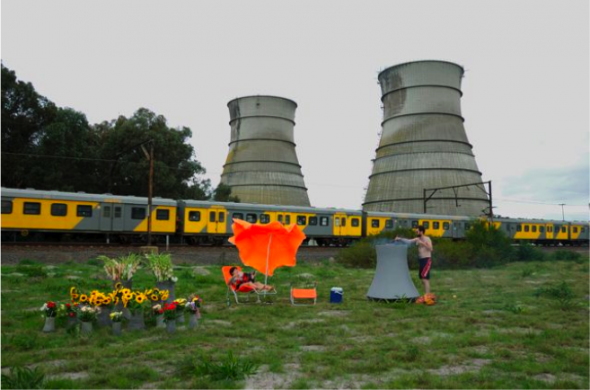 Kiluanji Kia Henda,2008. Nuclear Barbecue (da série Nuclear Garden of Mr.Young), Cape Town, 120cmx181,5cm.
Kiluanji Kia Henda,2008. Nuclear Barbecue (da série Nuclear Garden of Mr.Young), Cape Town, 120cmx181,5cm.
12:48 PM
me: What was your starting point for this project? It seems to me that you wanted to edit it in quite a different way from the other proposals for series or exhibitions. From my initial reading, I immediately realised that you had decentred the theme. Have you abandoned the thematisation of the narrative?
12:52 PM
K: It is important to state that the title of this series emerged when I had a gun pointed at my head. They are images that are inevitably connected to each other from that moment.
12:55 PM
me: That happened here in Brazil. I clearly remember the story of that situation when you were here. In fact, it had just happened.
12:56 PM
K: Yes, it was in Bahia.
10:30 PM
me: I see, in the phenomenon of hypermnesia and the idea of Jorge Luis Borge’s short story “The Secret Miracle”, some possible ways of exploring your work.
10:31 PM
K: Yes, that relationship exists. It arises in the description of the moment of tragedy to which I am trying to refer in the title, as well as in the selection of the images, which is a retrospective view of work carried out over the past three years. Without doubt, the idea of the retrospective creates a parallel with the state of hypermnesia.
10:32 PM
me: Like Hladik, the protagonist of Borges’s short story, you also suspended the possibility of the shot, like a secret miracle. It is in that suspension, which lasts a thousandth of a second (or the time that it takes for the raindrop to touch and fall off your face) but is mentally equivalent to a whole year, that Hladik has the opportunity to complete his previously unfinished novel. How would you describe your “drop of water”?
10:41 PM
K: I remember it was a time of great despair. I also remember that I felt that my head was not clear, that my brain had embarked on an automatic summary of my whole life, as if that proliferation of ideas were capable of distancing me or even eliminating the situation experienced at that precise moment. It is incredible how, in the face of particular circumstances, we cease to be ourselves in order to become spectators of our own lives, as if we were denying our existence or the present and painful reality, deliberately absenting ourselves from our intrinsic materiality.
10:45 PM
me: “There are days when I leave my heart at home…” seems, in this context, to be a sort of ante mortem confession, an anguished and desperate unburdening formulated, in retrospect, in the same way as a testament.
10:54 PM
K: In my head at that precise moment, that phrase meant that there was no forgiveness, that fate had been proclaimed. The intention of the aggressor, a policeman, was to cause me to lose all hope after several hours of grief.
11:01 PM
me: And then the brain goes off. In what way did the images that you chose echo the images that appeared to you, and how does that relationship materialize in this project?
11:08 PM
K: It turns out that the stories represented in these images convey several questions related to fear and insecurity about the future. My intention as an artist was to tackle various questions such as the nuclear issue, petrol, diamonds, negritude, drug addiction etc., factors that involve immense interests, and that postulate the idea that one should disregard the means in order to achieve the ends and that often lead us to leave our heart at home. The idea is to tell stories that could happen one day in anyone’s life, starting from pre-existing works produced within the scope of an inquiry into controversial and global themes. Temporal space, as well as physical space, the place that is inseparable from its own history, both exist among the images and were essential to the selection that I am presenting now. While I am seeking to convey large-scale themes with this project, there is a personal approach that exists in parallel. There is a lot of talk, for example, about how the Cold War is something that belongs to the past, but I am questioning the extent to which each of us is still affected by it in the present.
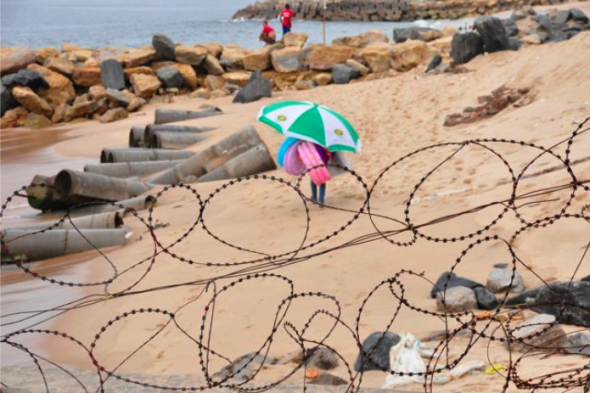 Kiluanji Kia Henda, 2011. The wires of shame and fear, 86,5cmx130cm.
Kiluanji Kia Henda, 2011. The wires of shame and fear, 86,5cmx130cm.
11:27 PM
me: So when you’re talking about a personal dimension you’re referring to your experience in a specific political context and the intimate and psychological implications that stem from it?
11:29 PM
K: I’m talking about the need to understand the individual through his or her political and historical context.
11:30 PM
me: Besides that, where do you locate your own subjectivity and the affection evident in the name
given to the project, and how do these elements intervene in it?
11:48 PM
K: In fact, the title is incredibly affectionate but at the same time it refers to a lack of latent affection. It refers to our enormous destructive capacity that so often places our hearts outside of the game, or simply leaves them waiting in a place that we consider to be home, the place that we imagine when we are wandering around the world.
11:55 PM
me: Is this what your work is proposing? Imagining home? Do you believe that your work has transformative potential in the sense that it points to the construction of another image of Africa, with the imagination functioning as an engine?
12:01 AM
K: I think I would be very pretentious if I thought that… I’m simply seeking to find certain common factors, between various points on the planet, in order to shorten distances and improve dialogue. But of course the epicentre is Africa, or Angola, to be more precise. It is important to consider how much of the rest of the world is in us.
5:06 PM
me: The selected images were reintegrated from series that I recognize. They form part of other stories; they are fragments of those narratives that work together here to construct a larger story. They project themselves equally into all dimensions of your experience as if it could signify all of these convulsions.
5:10 PM
K: There are many things in them that are born from certain personal traumas and these traumatic moments are directly linked to the history of the country where I have lived. However, they transcend continental borders and therefore simultaneously assume a personal, political and global dimension.
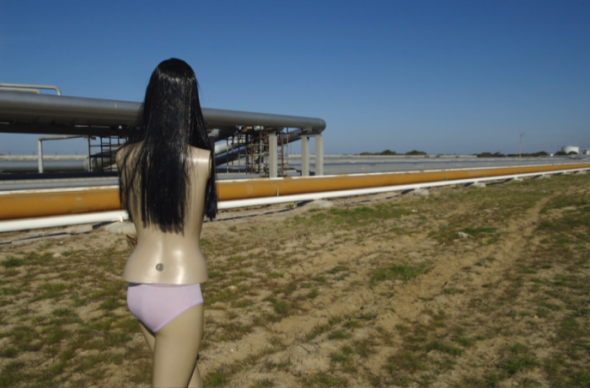 Kiluanji Kia Henda, 2008. Baby Lonia, Sines, 120cmx181,5cm.
Kiluanji Kia Henda, 2008. Baby Lonia, Sines, 120cmx181,5cm.
5:14 PM
me: Did you feel impelled by history or have you had the feeling that you are intervening in your images, in the sense of forging through them a power by which to transform the world, not only that of the people or of political power?
5:15 PM
K: I have always had the feeling that I have experienced the direct consequences of the globalisation of war. Since I was a child I have learnt that in Angola we were part of, or victims of, a great international strategy, and that what was happening was not caused only by our will. You are therefore compelled to adopt a position. I think that this awoke in me a concern for tackling themes on a broader scale.
5:29 PM
me: I read a recent article that contained some quotations from a statement of yours. You were talking precisely about these crossed references, like listening to Michael Jackson’s music on a Soviet radio when you were a child. What importance does the accumulation of such diverse repertoires have for your formation, which includes the squabbling and permanent presence in Angola of all the countries that want to form part of or determine its future?
5:35 PM
K: I grew up in an experimental period in a country that is as young as I am, where there has always been, political options aside, a great and accessible cultural and even religious freedom. For this reason, I think that we have an identity that is quite contaminated by what reaches us through the ports and airports, and now through the Internet and satellites. This happens not only in Angola but also in the rest of the continent, which has suddenly ceased to be the continent of the past in order to be sent into the future.
5:39 PM
me: And are you interested in working on this image of the future as a sort of justification for the process of historical overtaking or overcoming? Is that concern part of the Afrofuturist movement, which is particularly prominent in literature?
5:41 PM
K: There are two questions which are vital to the African context: the ability to write and know one’s own history, and the ability to plan one’s own future. Afrofuturism is an escape through which I am seeking to separate myself from the present. It does not obey a temporal rule, which allows a supposedly utopian future to be projected that sometimes interferes with the legacy of the past.
5:44 PM
me: The thorough restructuring and political affirmation of young nations, some of which are also young powers, depends on their ability to retell their own histories, opposing the perpetuation of the Eurocentric reading. Is that the aim of your work, to rewrite or reinvent history?
5:48 PM
K: Yes, whoever doesn’t have a history should invent one!
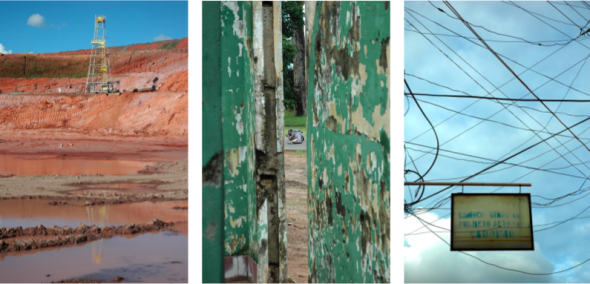 Kiluanji Kia Henda, 2010. Saurimo Conection, Lunda Sul, tríptico 130cmx86,5cm
Kiluanji Kia Henda, 2010. Saurimo Conection, Lunda Sul, tríptico 130cmx86,5cm
5:49 PM
me: That irony reminds me of a speech that Sarkozy gave in Senegal in which he said that Africa had never “entered into the history” of the problems of Africans. Is it self-determination that you are talking about?
5:51 PM
K: The important thing is that we feel that we have the legitimacy to define who we are or who we aim to be. The history forged by the universities also contains lacunae and manipulations. Moreover, it is clear that the process of mental decolonisation goes far beyond the political act of raising flags, holding parades in public squares and promoting discourses. For this reason, I think that it is very early to talk about post-colonialism, since there are still many weakened countries in Africa which are occasionally obliged to tolerate this type of paternalist discourse. Independence in Africa is a recent historical landmark, and strategies of dominance and neocolonisation are unfortunately not confined to the past. Sarkozy’s statement is indisputable proof of this danger.
1:57 AM
me: You are therefore confronting a sort of idea of historical falsification, which, like all history, obeys a particular interest and point of view, but which is subverted by you using the same method to produce the opposite effect, like a form of piracy.
2:00 AM
K: Exactly! In fact, it is the same strategy that was used in a negative way towards the African continent, and it was effective: the lie which it suits all of us to hear, and which makes us happy. I’m talking about the African context purely for personal reasons. As I have said, I believe that it is a history that is shared by other parts of the world. The fact that in five hours I can travel to Ethiopia by aeroplane when it took the Bantus thousands of years to reach Luanda is something that can never be trivialised. It is important to rethink the way in which we access globalisation, which, in our case, was in an obligatory and immediate manner: understanding the “other”, the foreigner, became absolutely essential for the survival of Africans. The ships that left here for the rest of the world were not occupied by tourists and were not following a tourist route.
2:16 AM
me: That necessary, urgent communicativeness shaped an open and perceptive attitude towards the other and adaptability.
2:18 AM
K: Yes, and it was also essential to our own sovereignty. It is incredible to reflect on the tremendous interdependence that currently exists among all humanity. If we know the other, and others know us, then tragedies such as Iraq could be avoided. Knowing that modern systems of communication depend on a mineral that comes from the Congo forests involves a moral duty to know more about that country.
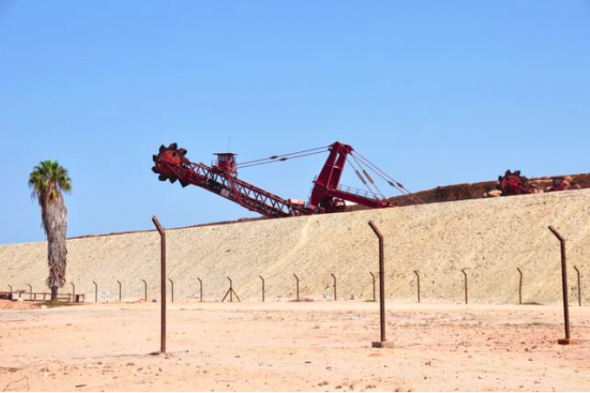 Kiluanji Kia Henda, 2009. Natureza Quase Morta, Namibe, 86,5cmx130cm.
Kiluanji Kia Henda, 2009. Natureza Quase Morta, Namibe, 86,5cmx130cm.
3:44 PM
me: We’ve talked about the political engagement of your work, which is in its roots and seems to be inextricable from it. It is its framework and its basic deflagrator. But when did you discover that art can give shape to this disquiet?
3:47 PM
K: My interest in producing art was always an interest in being able to reproduce extreme situations which I have experienced and which often transcended fiction. It springs from interaction with the streets, their laws and their myths. Since childhood, my attention has always been drawn to the mark left by time on things, the feeling of nostalgia and the lingering smell of other lives that have inhabited the city. Perhaps my interest in recording things sprang from there.
3:51 PM
me: It’s interesting that you mention reproduction. My image of the African continent – the image with which I was raised and educated – is a photographic image. When did you feel the need to move from reproducing to fictionalising?
3:57 PM
K: At the moment I believe that I am undergoing a change of skin as an artist. I decided to intervene in what was supposedly a mere documentary image, which came to acquire another significance when it underwent this process of manipulation. Feeding people the same poison with which we were fed. Sensationalism, omission or disorientation can be good tools when used in the artistic context. This is the most important freedom for me when entering fictional territory. “[…] Now if six turned out to be nine, I don’t mind”, as Hendrix sang.
4:04 PM
me: But how did you begin taking photographs?
4:05 PM
K: In the family, with my older brothers. We even came to have a studio at home. But later I got to know some photojournalists, like Carlos Louzada and John Liebenberg, who were heroes to me during my adolescence. Liebenberg, who is now a paparazzo, possesses one of the greatest photographic archives of the war. For me, it was amazing how much I learned about myself in his images. It was also where I discovered photography as a weapon of intervention and denunciation: in South Africa, it was also one of the main means used to unmask apartheid.
4:13 PM
me: When you met him were you taking photographs?
4:14 PM
K: No. At that time I was a student and I was more in touch with music. This was in the late 1990s, when I tried to form various groups that always resulted in frustrated projects. I believe that I connected to photography more through its contextual side because the truth is that I was always analysing images. I had photos by Cassiano Bamba, my brother, who had great freedom in what he was photographing because he did not take photographs in order to sell them. His images were always closely related to life in Luanda, from the musseques1 to the catwalks in the city, and he documented a sort of rebirth of glamour after independence. But strangely, I barely took any photos. I only reconnected with photography when I returned to Luanda in 1998, after spending two years in Johannesburg. The relationship with the downtown artists was very important for this reencounter in the sense that it encouraged me to search for an attitude or an artistic concept in what I was photographing.
12:01 AM
me: Like Liebenberg with Apartheid, you chose to insert in this project many images of Lunda Sul, the main setting of the massacres related to the “blood diamonds”. Some of these images, however, are very enigmatic, I would say almost abstract, such as Lunda in the Sky with Diamonds II, whose protagonists are the white soles of two shoes.
12:28 AM
K: Those boots belong to a miner. They couldn’t leave the mining area without washing their boots, because any stone, however insignificant it might be to the naked eye, can be highly valuable. Even the tyres on the trucks have to be washed. The experience that I had in Lunda Sul was very profound, and it possesses a dual connotation of affectivity and conflict.
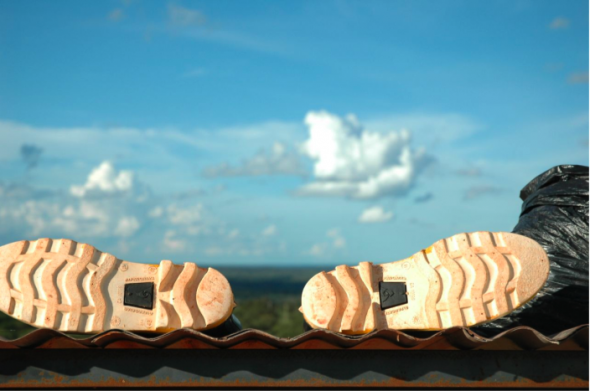 Kiluanji Kia Henda, 2007. Lunda In The Sky with Diamonds II, 86,5cmx130cm.
Kiluanji Kia Henda, 2007. Lunda In The Sky with Diamonds II, 86,5cmx130cm.
12:47 AM
me: Why affectivity?
12:50 AM
K: Because I had an adoptive brother who did his military service there, and he was killed during one of the battles. I grew up with the name of this province in my head because of the stories that he told me, from which I tried to create images of what this place was like as I had no photos. Much later, when I travelled there, it was incredible! It was very exciting to think that I was going to unveil a mystery that had always been alive in my subconscious. I heard only about the riches of the subsoil, but in fact I had never seen a more beautiful sky.
Published in the catalogue of the exhibition BES Photo 2011, Co-edition
Banco Espírito Santo / Museu Colecção Berardo, Lisbon, 2011.